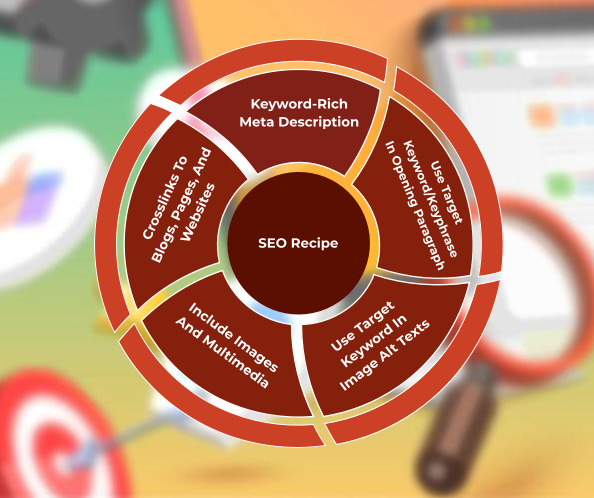5 Quick And Easy SEO Tips For Your Next Blog Post
I love blogging.
And in content marketing, blogging is often the blend of two of my favorite passions: writing and strategy (check out our copywriting services to learn more).
The writing part is obvious—I get to help companies communicate their messaging in their own brand voice.
But the strategy is less obvious (and often goes entirely unnoticed).
On the strategy end, blogging is a way to boost your SEO performance while garnering new and consistent web traffic—and potentially new sales.
With that in mind, let’s review some quick and easy SEO tips you can pull into your next blog post (learn more by checking out our SEO services).
5 Quick And Easy SEO Tips For Your Next Blog Post
Before hitting “publish” on your next blog post, run through this list:
1. Write a keyword-rich meta description.
Many writers forget about this one, and some even shrug it off.
But it’s an important step. A keyword-rich meta description helps search engines understand your content better, and it’ll also help them present your content better on the search engine results page.
If your team is currently blogging, don’t assume someone is actively writing those meta descriptions.
These things get overlooked—sometimes even by people you pay to write them!
For example: We recently audited a new client’s site. They’d used another vendor to write six blogs—but not one of those blogs had a meta description.
And although search engines like Google are smart enough to fill in their own link descriptions on the search engine results page, you shouldn’t leave this part to chance.
2. Get your target keyword or keyphrase into the opening paragraph (or at least the first quarter of the article).
This can be tricky, and it may even shift how you write your introductions. But getting your target keyword into the first paragraph has two benefits:
- It may push you to get to the point faster as a writer.
- It reassures the reader that you’re going to answer their initial question, which may increase dwell time (the amount of time they spend on your blog or website).
To put it simply: Get to the point.
3. Inject your target keyword into the alt text of your images and GIFs (when appropriate).
This tip is another way to funnel people to your site while also emphasizing your blog topic to search engines.
A solid image alt text strategy can dramatically increase your site traffic. There’s even research to suggest that a great image plan can account for 20%-60% of all of your traffic from Google.
This is also a good time for a quick reminder: Alt text matters.
Alt text is there to help search engines understand your site better and for people with disabilities to understand it as well.
At Poetica Marketing, we regularly audit sites and discover dozens and dozens (and sometimes hundreds) of images that don’t have alt text.
That’s a big issue, and it can take hours and hours and hours to fix—all because someone didn’t take the time to type it in when they uploaded the image.
Do yourself a favor. Use alt text!
Bonus Tip: Pay similar attention to your image file name. If necessary, change your file name so that it holds your target keyword.
That could improve your SEO performance much better than an image file called (for example) IMG_2077.jpg.

4. Include images and multimedia whenever possible.
This one is less of an all-out SEO enhancer and more of a user-friendliness enhancer (which can support SEO performance).
The reason we recommend a rich blend of images and multimedia is to break up the text and give more high-quality content for readers to engage.
In turn, this increases dwell time and improves the chances that the visitor will hang around to click on other pages—all while you build trust and increase brand awareness.
Dwell time is a factor for SEO through Bing. This has been clearly stated and verified by Bing.
Dwell time is not a factor for SEO for Google. This has been clearly stated and verified by multiple Google leaders in recent years.
Depending on your industry, the fact that it is beneficial to Bing performance may be more than enough to start focusing on multi-media content.
5. Crosslink to and from other blogs, pages, and websites.
A new blog is an opportunity to push people to other great content on your website.
But don’t forget to do the same for the post you’re currently publishing.
If you run a pet store and you’ve written an article called “The Top 5 Foods to Feed Your Lizard,” look for natural opportunities to plug the article in other blogs you’ve published in the past.
And while linking from these blogs, be sure that the hyperlinked text contains your target keyword for the new blog.
Of course, you should also look for other places to link to your article as well. If your blog contains original research or insights, it could be a candidate for:
- A citation in a third-party industry website
- A citation in a related Wikipedia article
- A citation in a related Quora thread
- A Reddit post
- Linking into a relevant online forum
Getting your blog linked from other sites increases the number of backlinks and potentially even your traffic!
Get Help With Your Blogs and SEO
For even more blogging and SEO insights, download your copy of my book, The Strategic Marketer.
Or, if you’d prefer, contact us! We’d love to hear more about your goals—especially when it comes to unlocking the advantages of content marketing.

Patrick Schober
Founder, Creative Director
Hi, I’m Pat! After spending a few years after college as an editor-in-chief for a company located outside of Philadelphia, I moved across the state to Pittsburgh and used my skills as a writer to transition into the exciting and competitive content marketing industry.
I started Poetica Marketing in 2018, and I’ve since helped companies and professionals all over the world enhance their online presence while increasing sales!
A writer at heart and a strategist by trade, I’m passionate about creating compelling written and visual content for SEO performance and social media.
When I’m not in the office, you’ll find me writing the latest article for Monster Riff, catching another rock concert, or diving deep into a book.
